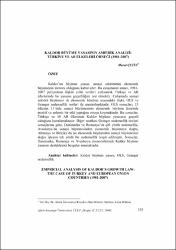| dc.contributor.author | Çetin, Murat | |
| dc.date.accessioned | 2014-12-16T12:24:07Z | |
| dc.date.available | 2014-12-16T12:24:07Z | |
| dc.date.issued | 2009-06 | |
| dc.identifier.citation | Çetin, M , , . (2009). KALDOR BÜYÜME YASASININ AMPİRİK ANALİZİ: TÜRKİYE VE AB ÜLKELERİ ÖRNEĞİ (1981-2007) . Afyon Kocatepe Üniversitesi İktisadi ve İdari Bilimler Fakültesi Dergisi , 11 (1) , 355-373 | |
| dc.identifier.issn | 1302-1966 | |
| dc.identifier.uri | http://hdl.handle.net/11630/1323 | |
| dc.identifier.uri | https://dergipark.org.tr/tr/pub/akuiibfd/issue/1627/20395 | |
| dc.description.abstract | Kaldor’un büyüme yasası, sanayi sektörünün ekonomik büyümenin motoru olduğunu kabul eder. Bu çalışmanın amacı, 1981-2007 periyoduna ilişkin yıllık verileri kullanarak Türkiye ve AB ülkelerinde bu yasanın geçerliliğini test etmektir. Çalışmada sanayi sektörü büyümesi ile ekonomik büyüme arasındaki ilişki, OLS ve Granger nedensellik testleri ile araştırılmaktadır. OLS sonuçları, 15 ülkenin 11’inde sanayi büyümesinin ekonomik büyüme üzerinde pozitif ve anlamlı bir etki yaptığını ortaya koymaktadır. Bu sonuçlar, Türkiye ve 10 AB ülkesinde Kaldor büyüme yasasının geçerli olduğunu kanıtlamaktadır. Diğer taraftan; Granger nedensellik testleri sonuçlarına göre, Danimarka ve Romanya’da çift yönlü nedensellik, Avusturya’da sanayi büyümesinden ekonomik büyümeye doğru, Almanya ve Belçika’da ise ekonomik büyümeden sanayi büyümesine doğru işleyen tek yönlü bir nedensellik tespit edilmiştir. Sonuçlar; Danimarka, Romanya ve Avusturya ekonomilerinde Kaldor büyüme yasasını destekleyici bulgular sunmaktadır. | en_US |
| dc.description.abstract | The Kaldor’s growth law postulates that industrial sector is the engine of economic growth. The objective of this paper is to test the validity of the law in Turkey, using annual data for the period 1981¬2007. In this study, the relationship between industrial growth and economic growth has been investigated by the econometric techniques of OLS and Granger causality tests. The results of OLS analysis indicate that industrial growth has a positive and significant effect on economic growth in 11 out of 15 countries. The results indicate that Kaldor’s growth law is valid in Turkey and 10 European Countries. On the other hand, according to the results of Granger causality tests it has been seen bidirectional causality in Denmark and Romania, unidirectional causality running from industrial growth to economic growth in Austria, and unidirectional causality running from economic growth to industrial growth in Germany and Belgium. The results provide further evidence to support the Kaldor’s growth law in Denmark, Romania and Austria. | en_US |
| dc.language.iso | tur | en_US |
| dc.publisher | Afyon Kocatepe Üniversitesi, İktisadi ve İdari Bilimler Fakültesi Dergisi | en_US |
| dc.rights | info:eu-repo/semantics/openAccess | en_US |
| dc.subject | Kaldor Büyüme Yasası | en_US |
| dc.subject | Ols | en_US |
| dc.subject | Granger Nedensellik | en_US |
| dc.title | Kaldor büyüme yasasının ampirik analizi: Türkiye ve AB ülkeleri örneği (1981-2007) | en_US |
| dc.title.alternative | Empricial analysis of Kaldor’s Growth law: The case of Turkey and European union countries (1981-2007) | en_US |
| dc.type | article | en_US |
| dc.relation.journal | Afyon Kocatepe Üniversitesi, İktisadi ve İdari Bilimler Fakültesi Dergisi | en_US |
| dc.department | Bozok Üniversitesi, İktisadi ve İdari Bilimler Fakültesi | en_US |
| dc.identifier.volume | 11 | en_US |
| dc.identifier.startpage | 355 | en_US |
| dc.identifier.endpage | 373 | en_US |
| dc.identifier.issue | 1 | en_US |
| dc.relation.publicationcategory | Makale - Ulusal Hakemli Dergi - Kurum Yayını | en_US |



















